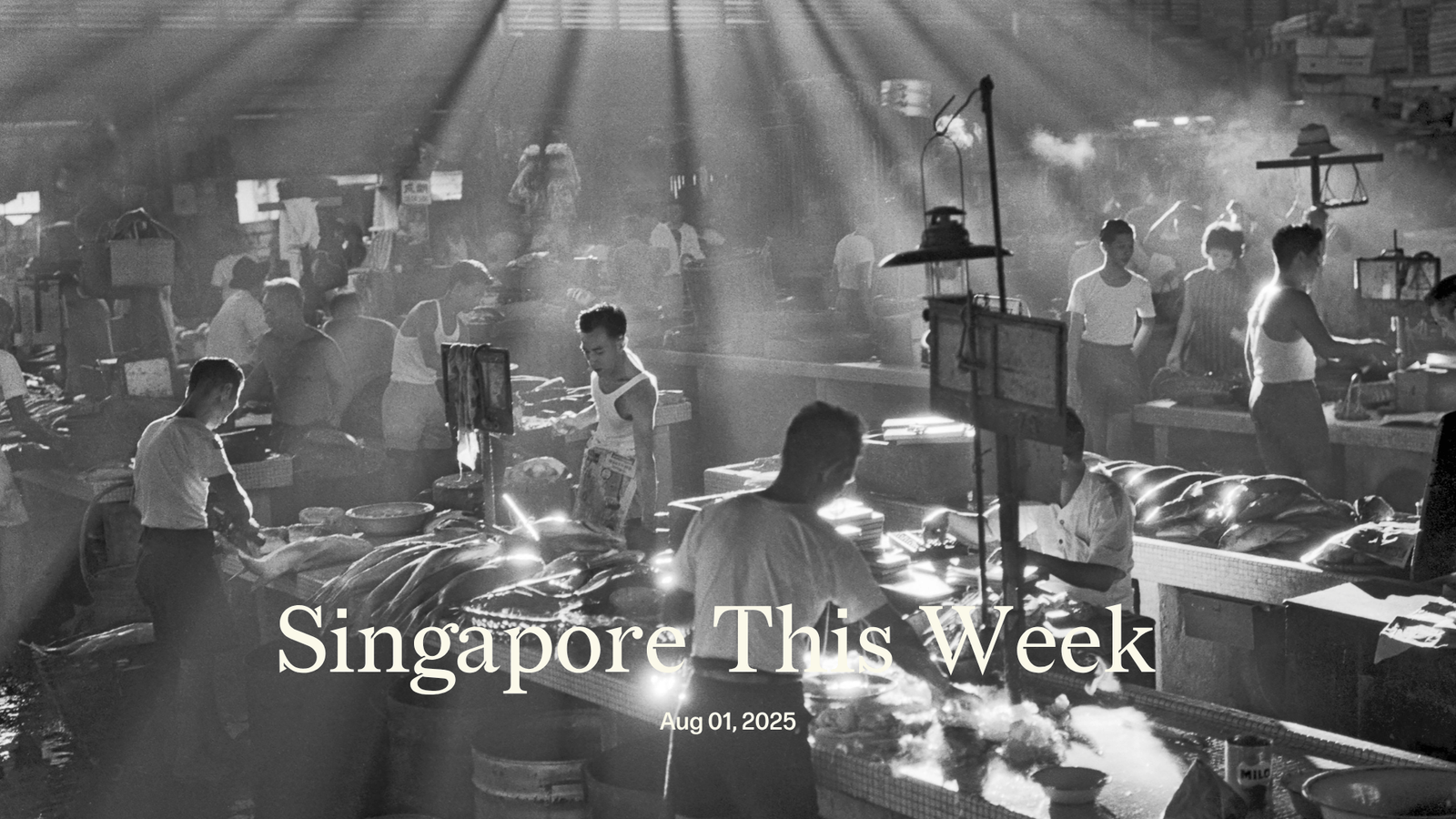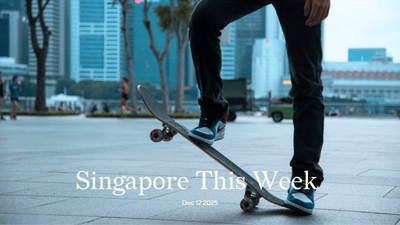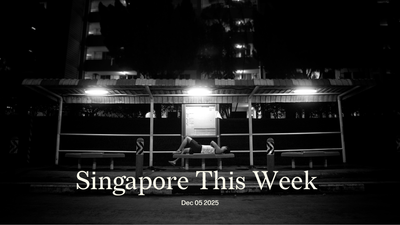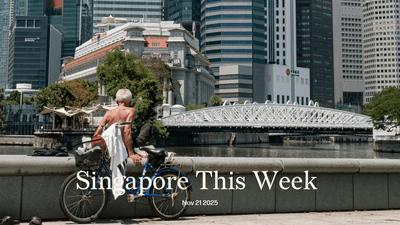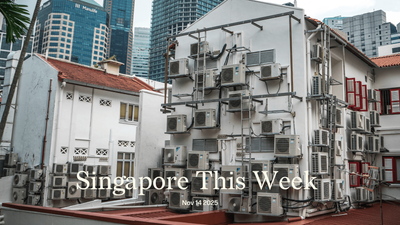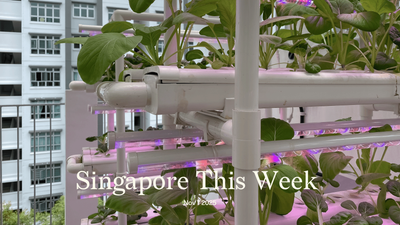Arts: Passing time with Lui Hock Seng
Every morning, he’d cycle from his home in Geylang to his job at Fraser and Neave, the beverage manufacturer, along River Valley Road, where he was due by 8am. He could do it in an hour. But he knew he’d dawdle, especially by the Merdeka Bridge, that busy commuter artery between the placid coast and the pacier city centre. So he always started out at 6am, also to catch the best light coming through the clouds. Slung around his neck was his most precious possession: a S$300 Rolleiflex camera, a present from his brother, who’d dug deep into his pockets for a high-end German model. What might a mechanic-turned-storekeeper do with such a handsome gift? He was drawn to patterns and geometries: silhouettes of seamen working beneath sail battens, like ribs against a bright sun; a labourer in a slant of light, pressed up against the crosshatched scaffolding of a rising building; a woodworker hewing rough logs into long, diagonal slats of timber. He didn’t know it then, but he was remembering the Singapore that his generation built, and that ours was starting to forget. He’d pull the camera up to focus with his left eye. While repairing a car, a metal splinter had struck his right, damaging it forever. But one was good enough. So were weddings and funerals, where he honed his craft. The occasional prize money from photo competitions was creatively and financially rewarding. So he kept making pictures, drawn to the daily rhythms of kampung life in Potong Pasir, Bedok and Tanah Merah, still lush with trees and flush with fields large enough for hundreds to gather for an impromptu silat performance. In 2012, he found himself a job at Singapore Press Holdings. While journalists and photographers collected bylines and the latest digital cameras, he collected their trash. He didn’t mind being an office cleaner. It was steady work, and he had an elderly wife and a disabled son to support. Then his younger colleagues discovered his black-and-white masterpieces and, for the first time, the 79-year-old became the focus of another’s lens. A French engineer, awed by his dramatic freezeframe of Ellenborough Market, its fishmongers resplendent in celestial sunlight, begged him for a print. It was the first one he’d ever sold. He would sell plenty more, aged 81, when the film and photography centre Objectifs mounted his first solo exhibition: “Passing Time”. There it was, his name in shiny black capitals on the gallery’s white walls. They had him stand next to it; he clutched at his soft khaki cap, slightly unmoored by the attention. But his lifelong companion, his trusty camera, with its strap pressing gently into his shoulder and back, grounded him. People showed up in droves and applauded his artist talks where, flanked by curators and gallery staff, he clapped for them, too. He had seven years left to live. Cancer would come for him. But he was satisfied—no, happy, even. He told his youngest son, before he died last week, that his wish had come true.
Arts: Dragon dreaming
It’s about 31 degrees celsius outside, not unusual for a humid Singaporean afternoon. In the belly of the Guan Huat Dragon Kiln, temperatures can go up to 1,300 degrees. That’s where a small group of us are sitting, wedged three in a row, elbow to elbow and knee to knee, waiting for a performance to begin. Artist anGie seah’s sonorous vocals, accompanied by the spare bassline of Ian Woo on guitar, vibrate through the 43m-long tunnel, where workers would once fire pipes, tiles, pots, and the latex cups demanded by every rubber plantation in the remote estate. Now, Singapore’s longest dragon kiln lies largely dormant, more frequently fed by body heat than flames fuelled by 10,000kg of wood. But, just for two months, seah hopes her site-specific tribute to the traditional kiln will rekindle a bit of its fiery former glory.
For the past few years, she’s occupied a small space at the Jalan Bahar Clay Studios, now managed by Focus Ceramics, which offers studio rentals and pottery equipment, among other ceramics-related facilities. Her exhibition, “a certain kind of courage”, runs till August 27th, and it gathers her work with ceramics, video and sound into an atmospheric collage of sensory experiences. You’ll need to duck to enter the low-ceilinged kiln, and you might get a light dusting of soot and silica on your cheeks and clothes. (“It’ll wash off,” assures Cissie Fu, seah’s creative collaborator, though she’s less certain about the stipple of mosquito bites adorning us all.) Braids of shiny ceramic are nestled loosely in crevices and cracks, and the luminous, flickering lighting allows us to imagine what stoking this furnace might have felt like. There’s also a nod to seah’s socially engaged work by way of a video of five members of her “seniors ensemble” projected on the kiln’s textured inner wall. The elderly women are each wielding walking sticks, and we hear the scratch of these staves on sand and gravel as they move slowly but steadily through a series of choreographed movements. seah’s always been interested in the sounds our bodies themselves can create, as sonic vessels; she’s “conducted” senior “orchestras”, where her retiree music-makers sigh, hum, clap and thwack their rattan canes to a score of symbols they’ve created. Her investment in ageing bodies will soon bring her to Trinity College Dublin, where she’ll spend the next year on an Atlantic Fellowship exploring equity in brain health. Being inside the reverberating kiln feels very much like being inside seah’s brain, a cavernous but cozy vessel built to house vessels from other fires.
Society: Migrating to a kinder society
Intrepid workers at a nearby construction site saved the driver of a car that had fallen into a yawning sinkhole along Tanjong Katong South Road. Pitchai Udaiyappan Subbiah, site foreman, stopped a colleague from climbing down, worried that the would-be rescuer would be trapped too. Instead, they threw a rope to the victim, who had managed to climb onto the roof of the upended car, and hauled them up. The consequences of a bus, or another vehicle with less spry passengers, falling in do not bear thinking about. (A day later, The Straits Times syndicated a story about 1,100 cave-ins and cavities on Japan’s highways in 10 years—yes, life is always worse somewhere else.)
The rescuers’ quick thinking and heroic actions have sparked a wave of appreciation. Dinesh Vasu Dash, minister of state for manpower, visited their dorms to award them with commemorative coins, akin to certificates of commendations. The Singapore Civil Defence Force (SCDF) announced that it too would recognise Subbiah and his peers’ efforts. A visit to the Istana may be in the offing after Tharman Shanmugaratnam, president, appeared to respond positively to a Facebook commentor’s suggestion that the saviours be invited for the National Day Open House on August 3rd. At least four laudatory Reddit threads sprang up: “These are the people I want Citizenship granted to. Period.” said one Redditor; “They built this country,” wrote another. Recognising that they might appreciate a material reward as much as a commemorative one, ItsRainingRaincoats (IRR), a migrant worker welfare group, launched a crowdfunding campaign. It met its S$70,000 goal within 96 hours. Earlier this year, a similar campaign for those who saved children from a burning building in River Valley also hurtled past its S$50,000 objective.
It is refreshing to see so many express their gratitude and support for our most vulnerable. Dare one say that such outpourings of goodwill show a growing awareness of the unjust foundations on which stands our gleaming cathedral to capitalism? Certainly, groups in aid of migrant workers have bloomed: apart from IRR, and the older, established ones like TWC2 and HOME, we now have Workers Make Possible, Sama Sama, Mutual Migrant Aid, Welcome In My Backyard and numerous others united in cause even as they differ in approach. All of us must continue to fight systemic injustices that make cases like Parti Liyani possible, and ideas like offshore dorms for construction workers utterable. But neither should we forget to nourish ourselves by celebrating the stirrings of our collective humanity.
Some further reading. In “Karl Liew: the case against the prosecution”, Carol Yuen reminds us of the abuse and injustices the most vulnerable people in this society have to contend with.
In “A missed opportunity to tackle debt-bondage faced by migrant domestic workers?” Robert Godden explains how foreign finance executives can unwittingly use unscrupulous agencies who perpetuate debt-bondage by charging migrant domestic workers excessive recruitment fees.
Society: Open up, bro
“How does a man tell his best friend he’s depressed?” Gary Stevenson, a YouTuber and inequality activist, asks rhetorically on “The Rest is Politics”, a British podcast. “He takes him to football, he sits next to him for 90 minutes, and he says nothing.” Stevenson, a former financial trader who last year published a memoir about life on high-stakes, testosterone-charged trading floors, is an advocate for more open, honest dialogue about male mental health issues. “So many people, especially young men, are quite unhappy and they tell themselves, ‘I’ll just work harder. I’ll make more money, I’ll work harder, I’ll make more money. If I make the money, I’ll be happy.’”
It’s a narrative common in Singapore too. The founders of Bros Before Woes, a male support group, told CNA about a workshop where attendees were meant to respond to “If I was more confident, I would …” with a personal reflection. A “typical finance bro” stood up and said, “If I was more confident, I would have bought Nvidia stock a year ago.” He sucked the air out of the room. Amidst the encouraging rise of similar groups, common themes emerge: societal expectations around status, productivity, and financial gain. Weekdays crammed with work, weekends for the family, no time for you and your bros. (“Mankeeping” is a new term that references the emotional labour borne by women whose male partners have nobody else to confide in.)
Meanwhile, a “provider expectation” saddles men with the notion that a successful career is a prerequisite for love. “I wish that ‘I want to marry you’ was enough, but many times, it seems like it’s not,” one said. Emotional vulnerability is frowned upon for many, who’re told not to cry from young. For elderly Singaporean men—bravado stemming from power walks paired with “Guess my age” inanities—CNA found that some perceive the very act of seeking help from active ageing centres as a sign of weakness.
Last year, almost two-thirds of reported suicides here were by men, according to the Samaritans of Singapore, and the largest increase was in the 30-39 age group. What can we do? Male-only spaces, whether void-deck carrom between unkers or meditative circles of young bros, provide safety in which emotional fluency can be cultivated and then transposed elsewhere, for instance in father-child relations. The erosion of institutions and spaces for men to naturally meet has been highlighted globally, notably by Richard Reeves, president of the American Institute for Boys and Men, as one explanation for the contemporary male condition. In the longer-term, the rejigging of traditional gender roles is key. Among other things, the distinction between “breadwinners” and “caregivers” must go. So jio a bro who’s a stay-at-home dad for a game at Jalan Besar—and tell him how you really feel.
Some further reading: In “Seeing the unseen: distribution of domestic thought and emotion work”, lawyer Nina Sugianto considers forms of domestic and caregiving work that are less visible, how the allocation of such work may be preventing couples from each achieving the best experience of family life and individual fulfilment, and what it takes for change.
Society: AI, but make it inclusive
Predictions of how AI will impact Singapore’s full-time labour force will no doubt have unnerved plenty. One 2018 study forecasted that about 20 percent of the country’s full-time workers would find their jobs displaced by 2028. Whether alarmist or prescient, these and other data convey an inevitability; that technological advances have and will continue to impact our rice bowls and exacerbate existing inequalities in the labour market. At a recent event hosted by the Institute of Policy Studies (IPS) and the Singapore Business Federation, Lawrence Wong, prime minister, argued that with every technological revolution, lost jobs were eventually replaced by better ones. “But this is not an economic law. This is just historical fact, and history may not guide our future.” He acknowledged that people have good reasons to be concerned about AI’s disruptive potential.
Still, Wong believes that Singapore’s compact size as well as strong tripartite ties between government, unions and employers, will enable the country to plan ahead—redesigning jobs, retraining employees—before new technologies are implemented. The government, he said, will have to think harder about how to help every company, especially smaller businesses, integrate AI into their processes; and how to apply these technologies in a “meaningful and deliberate manner” that creates jobs for Singaporeans. While Wong encouraged the broad-based application of AI across the entire economy, he also warned against rushing headlong into it. The power of technology, he said, must benefit rather than replace workers, ensuring that they thrive in a new environment.
Even as Wong stressed that Singapore has “no choice” but to harness AI, the “defining technology of our time”, it may be prudent to consider more cautionary voices. Despite its positive potential for good, in medical advancements for eg, Yuval Noal Harari, historian and bestselling author of Nexus: A Brief History of Information Networks from the Stone Age to AI, called generative AI an “unprecedented threat to humanity”. It’s the first technology in history, an increasingly “alien intelligence”, that can “make decisions and create new ideas by itself”, at a scale “far beyond what humans are capable of.” In the area of automation, Harari warned that AI poses a particular challenge to poorer developing countries, where “the value of unskilled labourers in left-behind countries will decline, causing them to fall even further behind.”
It’s not entirely clear how low-wage labour in Singapore will be affected. Geoffrey Hinton, the so-called “Godfather of AI”, has argued that jobs that require physical manipulation will be harder to replace than those that rely on “mundane intellectual labour” (like generating extremist tropes that might radicalise Singaporean youth, apparently). “So a good bet would be to be a plumber,” he said. In Singapore, robots may have already replaced some cleaning jobs, but can they ever perform the all-encompassing tasks of a domestic worker? Similarly, automation may enable the construction industry to reduce its reliance on migrant workers. But will the remaining ones see their pay and living standards improve? And what of those forced to return home? Given our commitment to narrow the development gap among ASEAN member states, this may be an opportune time to introduce reforms for an “ethical, responsible, and mutually empowering” labour migration, suggested Tappy Lung, a research intern at The Center for Strategic & International Studies. Creativity and empathy may no longer be the preserve of the human species, but we can still teach large language models a thing or two about being neighbourly.
Society: Prejudice stasis?
How have the levels of racism and other forms of bigotry in Singapore been changing? Not much, according to the latest edition of a survey conducted every five years by the IPS. Unlike in its previous two iterations, a clear majority of respondents believed that for every category—race, religion, age, gender, nationality, language and sexuality—prejudice was “about the same” as it was five years ago. Ageism has gotten worse for more respondents (17.6 percent) than any other form of prejudice. Private property owners were far more likely to feel it than those in HDBs, perhaps, IPS postulated, because the rich, “may stay active in professional roles longer, and may start to notice subtle shifts in how they are treated or valued, particularly in fields that prize youth, innovation or adaptability.”
Meanwhile, although sexism generally appears to have changed little, it’s been getting steadily worse for the youngest cohort (18-35). IPS attributes this to “more exposure to discussions around gender issues” and subsequent “heightened perceptions and sensitivities vis-à-vis instances of gender prejudice.” That’s probably a simplification, given that the next cohort (36-50) is as likely to have been plugged into post-MeToo narratives, but doesn’t exhibit anything similar. Perhaps we need more interrogations into these rising levels of sexism amongst our youth. Happily, bigotry based on nationality and sexual orientation appears to be steadily declining for all groups.
With race, kudos to IPS for a comprehensive survey, including new questions and explanations relating to Critical Race Theory. They reveal a divided society. A question on lived experiences asked about various forms of harm, from “being made fun of because of your race” to receiving “comments that your positive behaviour is an exception which other members of your race and/or religion do not exhibit”. For Malays and Indians, the share encountering these at least “sometimes” is worrying (respondent percentages in the 20s-30s, depending on the harm). Meanwhile, for Malay, Indian and “Others” respondents, well over 60 percent agree that “racism is a common experience for racial minorities”, and well over 50 percent that “Chinese Singaporeans will only encourage racial equality if it promotes their self-interest.” A majority of all respondents, including Chinese, believe that “it is easier to be a Chinese Singaporean in Singapore”. So yes, racism has largely stayed the same over the past five years, but is that level healthy? Apparently so. Yes, IPS warned against complacency and stressed the importance of interventions in schools, workplaces and elsewhere, such as its own IPS Programme on Race, Religion, and Intergroup Cohesion. Still, the government-funded and -controlled thinktank will likely never be able to deeply interrogate any political roots of racism, such as Lee Kuan Yew’s words or immigration policies that give preference to ethnic Chinese. IPS concluded that the findings paint an “optimistic picture” and praised “Singapore’s continued success in managing racial and religious diversity”. The ideological handmaiden of ownself check ownself, after all, is ownself praise ownself.
Some further reading: “Prejudice, attitudes and critical perspectives on race in Singapore” by IPS. Jom’s perspective on racism here differs from IPS’s, and may differ from yours, so we urge you to read the report, and form your own conclusions.
History weekly by Faris Joraimi
Bidadari Park may be the most interesting new pleasure ground in town. Opened late last year, it was recently reviewed in the world-famous Italian architecture magazine Domus. While now the central green of infant BTO estates Woodleigh Glen, Woodleigh Hillside, and Bidadari Park Drive, the site has a fascinating past connecting some of Singapore’s most colourful characters. It occupied both the former Bidadari Cemetery as well as the neighbouring Alkaff Lake Gardens. The place-name Bidadari—or widadari in old Javanese, and vidhyadari in Sanskrit—means “fairy”. It refers to the Istana Bidadari where Zubaidah Abdullah (née Cecilia Lange), the Danish consort of Johor’s Sultan Abu Bakar, lived in the 1860s-80s. The municipal authorities acquired the land in 1902 and turned it into a Christian cemetery; a Muslim section was added in 1910, and a Hindu and Sinhalese section added in 1929. Around then, the Hadhramī Arab notable Sayyid Shaykh ‘Abd al-Rahmān al-Kāff acquired a section of the cemetery to build a Japanese-styled pleasure garden, replete with teahouses, granite-chip paths, and timber bridges over an artificial lake. The Alkaff Lake Gardens was a popular dating spot, but fell into disuse by the late 1930s. Then came the Japanese Occupation of Singapore (1942-45). Only decades later, after warming ties of investment and tourism had sweetened the ground, would another Japanese garden emerge in Singapore.
But the cemetery itself was a remarkable record of Singapore within various webs of historical interaction. Among others, there were buried Zahara Binte Noor Mohammed (1907-1962), activist and founder of Singapore’s first Malay women’s welfare organisation; Charles Joseph Pemberton Paglar (1894-1954), physician and president of the Eurasian Welfare Association; Benjamin Keaseberry (1811-1875), Protestant missionary and pioneer of Singapore’s Malay publishing industry; Lim Boon Keng (1869-1957), Chinese Peranakan social and educational reformer; and Sharif Masahor (1800-1890), a Sarawakian nobleman who rebelled against the “White Rajah” James Brooke.
But the dead, no matter how celebrated, must make room for the living in Singapore, as Jean Tay’s play “Boom” (2007) explored. In the early 2000s the whole cemetery was exhumed for “development”, with significant tombstones rehoused at the Bidadari Memorial Garden in 2004. They remain today at the new Bidadari Park. Instead of the Lord Sayyid’s Japanese taste, Henning Larsen—a brand-name Danish architectural firm—conceived a design retaining existing environmental features. Mature woodlands, gentle knolls, and marshlands supporting local biodiversity are integrated with state-of-the-art stormwater management systems. NParks touts the outcome as proof that “it is possible to strike a good balance between development and nature conservation.” Until, that is, the animals encroach into the BTOs. I’d rather not wonder about the dead who linger.
Tech: Chocolate Finance’s bittersweet expansion to Hong Kong
Singapore’s Chocolate Finance is making its first overseas foray, into Hong Kong, armed with fresh US$15m (S$19.4m) funding and hard-earned regulatory licenses. However, its expansion comes with the lingering aftertaste from a rocky year. The fintech startup, which offers daily-return cash management services, saw 40 percent of its assets vanish in two weeks in March after bungling communications around its AXS payment partnership termination. Founder Walter de Oude admits they “focused on managing the press” over customers, a misstep that levelled Assets Under Management at US$705m (S$913m), down from its US$1bn (S$1.3bn) peak.
Hong Kong is both opportunity and minefield. Its cash-rich market (Asia’s fourth highest GDP per capita) aligns perfectly with Chocolate’s target segment. And the firm is now licensed to trade securities and manage assets—crucial for replicating its Singapore success. Yet its expansion timing raises eyebrows: can it convince Hong Kong investors to pour cash into its short-term fixed-income funds while still recovering from a trust deficit? Why would locals choose Chocolate when competitors like Endowus, StashAway and Syfe already have footholds there? Strategic partnerships may hold the answer. With lead investor Nikko Asset Management, Chocolate gains credibility and fund management expertise. But as it eyes Japan next, the startup must prove it’s learnt from its “messy” past, because in wealth management, trust isn’t just sweetener; it’s the main ingredient.
Tech: Carousell goes from garage sales to Gucci
For over a decade, “Carousell lah” has been the Singaporean shopper's first instinct when hunting for good deals. The homegrown platform revolutionised secondhand shopping in the region, turning clutter into cash with one photo. But last year’s financials revealed a rebirth up the value chain: as losses shrank by 13 percent and revenue grew by 2.9 percent, Carousell was quietly transitioning from garage sale to high street fashion, a la ThredUp. This was done through the acquisition of LuxLexicon and the expansion of Refash, resellers for high-end luxury and pre-loved fashion. Yet this upmarket move risks alienating the very users who made Carousell a verb. Can a platform built on S$5 used textbooks and secondhand furniture truly become the region's answer to The RealReal, the online American retailer for authenticated luxury items?
With US$85.6m (S$111.1m) in reserves, Carousell has breathing room to execute its strategy and will be opening several luxury physical stores across Hong Kong, Kuala Lumpur and Singapore. But in its quest for profitability, the company must tread carefully. After all, you can take the startup out of the garage sale, but can you take the garage sale out of Singaporeans’ hearts? The next time you are Carouselling for a bag, an expensive Chanel rather than a cool tote might pop up, and that cultural shift could be Carousell's biggest challenge yet.
Faris Joraimi, Abhishek Mehrotra, Corrie Tan, Tsen-Waye Tay and Sudhir Vadaketh wrote this week’s edition. Liyana Batrisyia contributed.
If you enjoy Jom’s work, do get a paid subscription today to support independent journalism in Singapore.


